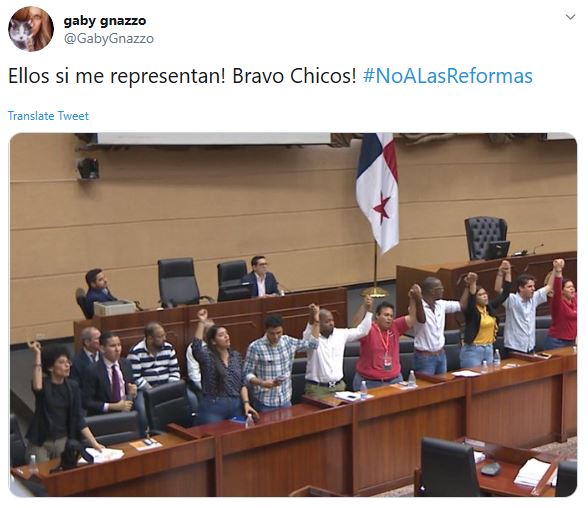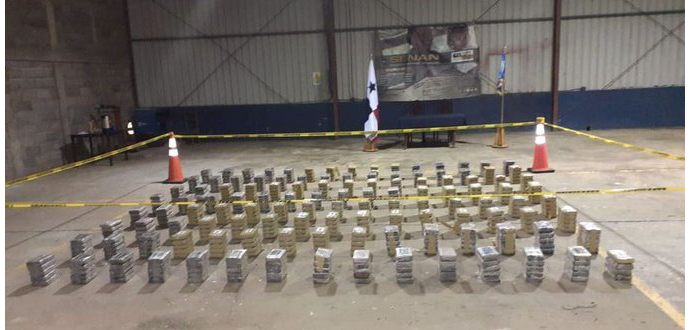A trophy photo by Panama’s combined air patrol and coast guard, the National Aeronaval Service (SENAN). In his recent speech to the nation about his first six months in office, President Cortizo hailed 2019’s record haul in drug seizures like this one, but lamented a spike in homicides. He did not draw the connection, but in the course of the never-ending “War on Drugs” smuggling routes shift around and when they come through Panama gang warfare also increases, particularly in the aftermath of some large shipment being waylaid.
The world’s crisis affected Panama and the region in 2019
by Marco Gandásegui, hijo
On the global level, 2019 followed a pattern set by a crisis of capitalist development. The economic growth rate continued to decline and negative social development threw ever more families into the ranks of poverty. The trade war between China and the United States expressed this crisis in geopolitical terms. In turn, Trump’s presidency is a sign of the hegemony crisis that shakes the United States. The question is whether the capitalist world-system is in a terminal crisis (as Wallerstein said) or if the crisis of hegemony is only of American capitalism, which awaits its successor (as Arrighi maintains).
In Latin Americ, in 2019, students of political processes abandoned their theses on cycles and the United States continued to intervene in the internal affairs of the region. Washington removed President Evo Morales from Bolivia through a barracks movement, increased arms sales to governments under its warmongering policies and threatened Cuba, Venezuela and Nicaragua with military invasions. At the same time, however, anti-neoliberal governments emerged in Mexico and Argentina. The Lima Group and the OAS continue to create anxiety under US leadership. Despite the bad omens, social movements in the region created hopes for new awakenings in the countries of the region.
In Panama, the country showed signs during 2019 of sinking more and more into a chaotic tangle of corruption, the outcome of which is unpredictable. The system feeds on corruption, which is strengthened by public policies of the last 30 years that generate growing social instability and political ungovernability. The lack of governance is coupled with a rapid decline in the rate of economic growth in recent years. While between 2008 and 2011 the annual GDP growth rates were double digits, between 2016 and 2019 they decreased to only 3.5 percent annually.
In 2019 Panama held elections for a new president and other public positions. As in the last 30 years, three political party machines maintained their control. In this case, the Democratic Revolutionary Party (PRD) and its candidate Laurentino “Nito” Cortizo won by a very small margin. The new president said he will end corruption. To end this scourge, the political and economic system must be transformed. Cortizo does not intend to go so far. In the first six months of his administration corruption scandals have erupted and have not been confronted.
After leaving the presidency that he held between 2014 and 2019, Juan Carlos Varela’s compromising WhatsApp conversations with senior officials came to light. The recordings that were made public were baptized as the “Varelaleaks.” Earlier, the previous president, Ricardo Martinelli (2009-2014), was acquitted for technical reasons of spying on his political adversaries. In a period of 10 years it is believed that the treasury lost billions of dollars due to mismanagement of the national treasury. In other branches government, legislators and magistrates of the Supreme Court were also accused of corruption.
In 2019, Panamanian public health services, schools and law enforcement collapsed. Environmental programs, transits through the Panama Canal and agriculture also had serious problems that resist solution. The Social Security Fund (CSS) that manages a budget of more than $3 billion annually is insolvent due to corruption. The lack of planning in the construction of health centers that remain unfinished and the payments for services that are outsourced are parts of the system’s malfunctions. Likewise, the lack of planning in the education sector generates waste and more corruption. At the end of the year the most terrible prison massacre in Panamanian history took place when 15 inmates were killed inside the La Joyita penitentiary. Those who were in charge attempt to distance themselves from the tragedy by claiming that it was just part of a war between gangs.
School dropouts increased in 2019 and makeshift “bohio schools” serve more and more children. The national budget covers fewer of the needs of the population and bad planning finds schools where there is no population and population where there are no schools. In the health sector, resources are diverted and thus not destined to the acquisition of medicines, maintenance or the training of specialized personnel. Poverty is criminalized but a blind eye is turned to white collar crimes in the financial sector.

In Brazil with an election rigged by corrupt court rulings and in Bolivia with a US-backed white supremacist military coup, far-right evangelicals have taken over governments. In Costa Rica such folks came close to winning the last presidential election and in Panama they have become a force in the National Assembly. Oscar nominee actress, journalist and activist Gaby Gnazzo was thrown out of the National Assembly’s press gallery and she and others were excluded from the public gallery, among other things on a made-up “rule” about how lesbians, gay men, bisexuals and transgendered people are not allowed on the legislature’s premises. Protests against the shift to the far right in the PRD-dominated legislature brought in the riot squad to make dozens of arrests, almost all of them for nothing that could stand up in court. The argument over business groups’ proposed cosmetic changes to the constitution and demands from left and right for far more substantial changes continues.
Contact us by email at fund4thepanamanews@gmail.com
These links are interactive — click on the boxes












